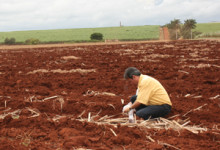Be In The Game
 High crop prices have monopolized the news again this winter, but your grower-customers know they can’t just pass “Go!” and collect $200 this season. The stakes are too high. The profit potential intensifies the need to maximize grower input dollars — and that’s where your dealership’s diverse offerings, such as soil testing and scouting, come into play.
High crop prices have monopolized the news again this winter, but your grower-customers know they can’t just pass “Go!” and collect $200 this season. The stakes are too high. The profit potential intensifies the need to maximize grower input dollars — and that’s where your dealership’s diverse offerings, such as soil testing and scouting, come into play.
Sampling Saves $
Corn and soybean prices may hit some record numbers, but on the cost side of the ledger, fertilizer isn’t exactly cheap. Wasted materials and money are not an option for your growers. Offer soil testing services as the first step toward proper placement.
Typically performed in the fall by staff or outside help for corn and soybean fields, soil sampling is sometimes carried over into spring. Its basic purpose is to outline a field’s fertility and pH levels.
Philosophies on how often to pull soil samples vary. For example, Hovey Tinsman III, president of Davenport, IA-based Twin State, Inc., makes the case for four-year cycles in corn and soybeans. “We frankly don’t even sample bi-annually because the only reason to sample that often is a) we haven’t had a history with you or b) you’re doing some major management change,” he says. “What we’ve found is when we have tested every other year, people basically don’t change what they actually do based upon what we find, so it’s a waste of time.”
Two- to three-, even five- to six-year intervals were mentioned during interviews with several CropLife 100 operations, depending on such variables as conventional vs. precision program sampling, along with the cropping system. On the other end of the spectrum, Mountain View Co-op, Black Eagle, MT, encourages its wheat growers to test every year, says Frank Schumacher, operations manager.
Variety Of Programs
Sampling practices follow a range of styles, divided between traditional and precision programs, and charges run the gamut, from free to per acre to grid size. There are even those growers that choose a mix of conventional and precision programs. “They might have fields that yield really well and are fairly consistent and they just pull a regular sample out to keep everything in check,” while utilizing a precision program for fields they’re trying to build up, explains Brad Murray, precision agriculture specialist for Landmark Services Cooperative, Juda, WI.
Landmark has offered grid soil testing for a dozen years. “If you figure out how much plant food costs now, it’s outrageous — just more than quadrupled in the last two to three years,” Murray says. “When you take a product and put it in a spot where it’s not needed, that is so much wasted money.”
The co-op’s precision program provides analysis of past practices. “Our general consensus between our sales force and our customers is that about 60% of our plant food was applied in the wrong spot, Murray says. “If you’re wasting 60% of something that costs upwards of say $100 an acre to apply, that’s a lot of money wasted.”
Murray attributes a substantial uptick in precision agriculture sign-ups the past three years to the rise in fertilizer prices during that same time frame.
“We use soil testing to determine what their requirements are for the crop based on yield goals and offer our own liquid fertilizer blend to fulfill that requirement,” says Larry Moir, sales representative at Centennial Ag Supply, Kersey, CO.
Appreciable Art
The retailer’s ability to create the final recommendations helps determine where, what type, and how much of a grower’s fertilizer input dollars will be spent. It’s an art, says Twin State’s Tinsman. “Developing recommendations certainly has scientific aspects, such as the lab work,” he says, “but everybody has different interpretations on how they want to use different soil test components.”
Twin State, for example, uses several components to build its recommendations. “The recommendations are based upon what the soil tests call for first; second, based upon the crop; third based upon their intended or expected yield; and then to a lesser degree, previous crop,” says Tinsman.
Success Happens
Soil testing can make a measurable difference in a field’s performance. Just ask Dan Kennedy of Ritter Crop Services, Inc. in Marked Tree, AR.
He cites the changes due to using variable-rate soil testing on a customer’s farm this past fall. “We would normally go in and apply 1 to 2 tons of lime across every field — 7 — on this farm,” Kennedy says. The soil tests “actually cut in half what we thought we were going to need.”
Scouting Makes Its Mark
Scouting is another service that will ensure your growers use the right herbicide, insecticide, or fungicide when needed. Your dealership may offer scouting services, or your growers may walk the fields themselves and call if the situation warrants spray application.
A key weed concern in 2008 glyphosate resistance — especially when combined with resistance to other herbicides. Some waterhemp has shown resistance to glyphosate, ALS, and PPO-inhibiting herbicides.
Glyphosate resistance in weeds should be on your watch list. “A basic recommendation is to spray when the weed is smaller than usual, then check seven to 10 days later for weed escapes,” says Mark Loux, Ohio State University weed specialist. The list of resistant weeds includes marestail, common ragweed, giant ragweed, amaranth, waterhemp, hairy fleabane, Italian ryegrass, and rigid ryegrass. Most of it is in the eastern Corn Belt and the mid-South. Glyphosate-resistant johnsongrass was confirmed in Arkansas and Mississippi in mid-March.
Missouri is the first state where three glyphosate-resistant weeds — tall waterhemp, common ragweed, and horseweed — have been identified. Kevin Bradley, University of Missouri weed specialist, recommends using different modes of action to lessen the impact of resistant weeds. It won’t be an easy sell, because the best systems cost twice the amount of a typical glyphosate application regime. Liberty Link soybeans can be used, and dicamba-resistant soybeans may be available by 2013.
Glyphosate-resistant waterhemp is a major concern for the 2008 season “due to the widespread adoption of weed control in lieu of weed management,” writes Aaron Hager, University of Illinois (UI) weed specialist, in a UI newsletter. The glyphosate application should be preceded by an early soil-residual herbicide. Hager emphasizes that treated fields must be scouted seven days after the initial glyphosate application to determine treatment effectiveness on waterhemp.





